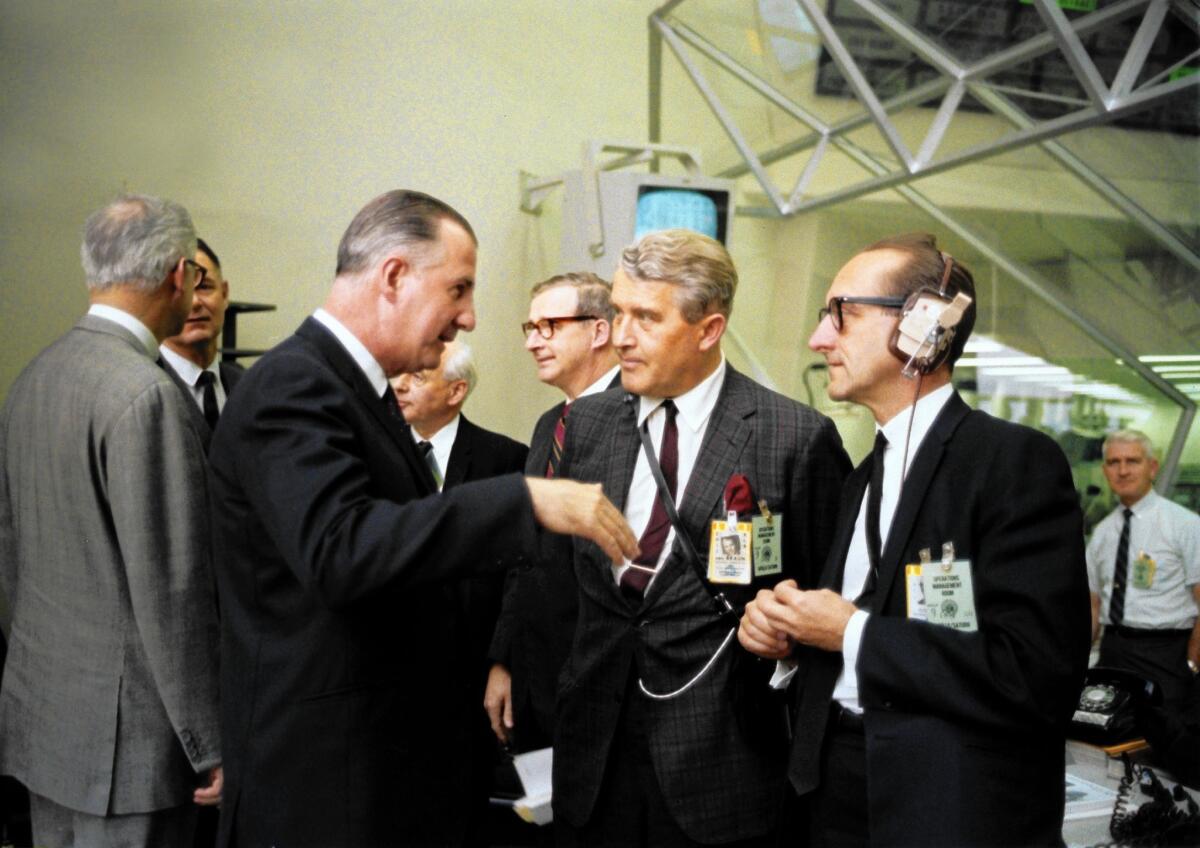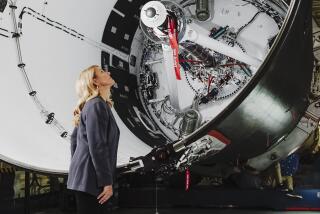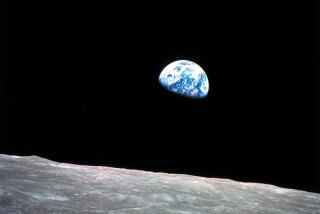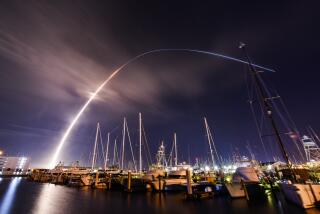George Mueller dies at 97; key figure in U.S. quest to land a man on moon

In 1969, Vice President Spiro Agnew, left, speaks to German rocket scientist Wernher von Braun, center, and NASA’s George Mueller before the launch of the Apollo 9 space mission at Kennedy Space Center, Florida.
In 1961, President Kennedy outlined a bold plan for America: to land a man on the moon and return him safely to Earth before the end of the decade.
Even for a nation of dreamers and builders, it was an audacious goal. But George Mueller, a quiet, steely engineer who was head of manned space flight at NASA, had an equally audacious solution.
He proposed that NASA abandon its lengthy process of testing rockets one stage at a time in favor of an “all-up” approach — launching all the pieces at once.
“It sounded reckless, but George Mueller’s reasoning was impeccable,” Wernher von Braun, the German scientist who oversaw the building of the Saturn V rocket that would put American astronauts on the moon, later wrote in a NASA history. “In retrospect it is clear that without all-up testing the first manned lunar landing could not have taken place as early as 1969.”
Mueller, whose strategy and administrative skill were widely credited as instrumental in the space agency’s ability to meet the president’s deadline and beat the Soviets to the moon, died Oct. 12. He was 97.
The cause was congestive heart failure, said his friend Arthur L. Slotkin, author of “Doing the Impossible: George E. Mueller and the Management of NASA’s Human Spaceflight Program.”
Although not a household name like Neil Armstrong or Buzz Aldrin, the farsighted Mueller (pronounced Miller) also laid out the conceptual design of the Skylab, the first manned space station. He is often described as the father of the space shuttle for his early advocacy of a reusable space transportation system.
“George Mueller’s leadership and vision for the Apollo project contributed much to one of humanity’s greatest success stories — the Apollo 11 lunar landing,” Jim Albaugh, president of the American Institute of Aeronautics and Astronautics, said in a statement this week.
“He was dedicated to the idea that the landing could be achieved, and he laid the organizational groundwork within NASA to make it happen.”
Mueller was born in St. Louis on July 16, 1918, the eldest son of Edwin and Ella Mueller. A boyhood interest in building model airplanes and radio receivers led him to train as an electrical engineer at the Missouri School of Mines, where he earned a bachelor’s degree in 1939. The next year he received a master’s degree from Purdue University.
During World War II he worked on developing airborne radar systems as a researcher at Bell Laboratories. After the war he joined the faculty at Ohio State University, where he earned a doctorate in physics in 1951.
In 1953 he went to work at the Ramo-Wooldridge Corp. (later part of aerospace giant TRW), where he worked on radar designs for the Titan missile. He was a TRW vice president when he was hired by NASA in 1963.
He quickly pushed for a management overhaul that put NASA’s space flight centers in Alabama, Texas and Florida under his supervision.
In 1964, Von Braun recalled in the NASA history, Mueller visited him at the Marshall Space Flight Center in Huntsville, Ala., and “casually introduced us to his philosophy of ‘all-up’ testing.” The concept shocked Von Braun and his fellow rocketeers on the Saturn V project, but Mueller’s faith in the approach was unshakable and his powers of persuasion formidable.
“George Mueller convinced us not with a technical argument but with a psychological argument,” Ernst Stuhlinger, another rocket scientist on von Braun’s team, recalled in a 1999 interview with ABC News’ Peter Jennings. “He said, ‘You guys, you are so good. You have so much experience. You are the best team in the world. You can do it.’”
Mueller’s confidence also came from his belief “that there wasn’t any other way we were going to get the program done on the schedule that we had,” he told Air & Space magazine in 2011.
After only two test flights of Saturn V, the three-astronaut crew of Apollo 8 became the first to orbit the moon and return to Earth, on Dec. 21, 1968.
That mission paved the way for Apollo 11, which was launched July 16, 1969 — coincidentally Mueller’s 51st birthday.
It reached the lunar surface July 20 — beating Kennedy’s deadline by five months.
“This day man’s oldest dream is made a reality … the ancient bonds tying him to the earth have been broken,” Mueller wrote in a lengthy piece for the New York Times on July 21, 1969. “With the achievement of the first manned landing on the surface of the moon, we have accomplished the most momentous feat in the long history of man.”
Mueller’s tenure was not without controversy: In 1967 three astronauts were killed during a launch test. But Mueller remained in his job because he was, NASA administrator James Webb said at the time, “one of the ablest men in the world.”
Decades later, Mueller suggested that his era’s gung-ho attitude was a major factor in the Apollo program’s ultimate success.
“We have too many people who believe in absolute safety, and there is no such thing,” he said in the Air & Space interview. “And unfortunately, if you designed your program to be absolutely safe, you’d also be sure you’d absolutely never fly.”
Four months after the moon landing, Mueller left NASA for management positions in the aerospace industry. A 1970 recipient of the National Medal of Science, he later served as president of the International Academy of Astronautics.
Mueller came out of retirement in his late 70s to head Kistler Aerospace in Kirkland, Wash.
He often lamented the end of the Apollo program and “the lack of a vision of where man is going in space,” as Mueller put it in a 1998 oral history for NASA.
“You think of the pioneers that opened up the West. Well, you ought to think of pioneers opening up space in the same fashion,” he said. “If we’d only found diamonds on the moon, we would have been able to really get that program going.”
His survivors include his wife, Darla; four children; 13 grandchildren; and 13 great-grandchildren.
More to Read
Start your day right
Sign up for Essential California for the L.A. Times biggest news, features and recommendations in your inbox six days a week.
You may occasionally receive promotional content from the Los Angeles Times.







